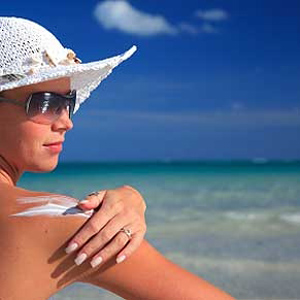
Maybe you’re thinking, what’s the big deal, in the whole scheme of things? Or, how can I ever get my teen to use sunscreen, especially when she and her friends are competing for the “golden glow” award?
Well, I’m here to tell you it’s worth a try. Here’s why: Sunburn is a sign of skin damage from ultraviolet (UV) rays. Repeated sunburns increase your risk for skin cancer.(3) That risk is even higher in people with lots of moles and freckles, very fair skin and hair, or a family history of skin cancer.(4) One type of skin cancer (melanoma) is on the rise.(5) Although once a cancer of older people, cases are now also showing up in young adults and teens. This could be due to their increased use of tanning beds and sun lamps.(5)
Too much UV exposure can also cause other types of cancer, cataracts, and a weakened immune system.6 And it can lead to wrinkles, age spots, and leathery skin, making you age before your time.5 (Perhaps this will get the attention of those “invulnerable” teens!)
Of course it’s not realistic – or right – to ask your kids to stay out of the sun altogether. So do you best to encourage respect for the sun, not sun worship. Buy a broad-spectrum sunscreen, blocking both UVA and UVB rays, with at least SPF 15. And encourage your teen to:
• Wear sunscreen or a moisturizer with at least SPF 15 every day.
• Apply the sunscreen thickly.
• Reapply every couple of hours after swimming or sweating.
• Stay out of the sun as much as possible between 10:00 am and 4:00 pm.
• Wear a wide-brimmed hat and sunglasses with 100 percent UV protection.
• Remember that both water and snow reflect UV radiation and can increase the risk of burns.
• Avoid tanning pills that claim to speed up tanning.
And, by the way, plenty of UV rays seep through sunscreen to help your body get enough vitamin D. So that’s not a reason to avoid sun protection.
If your teen still insists on getting a tan, suggest trying sunless self-tanner, which contains dihydroxyacetone (DHA). Available in sprays, lotions, moisturizers, and towelettes, these products gradually stain dead cells in the skin’s outer layer. The effect can last up to a week. (5)
You can find many sun-protection products in our store. If you can’t find what you’re looking, don’t hesitate to ask for help.
Nothing herein constitutes medical advice, diagnosis or treatment, or is a substitute for professional advice. You should always seek the advice of your physician or other medical professional if you have questions or concerns about a medical condition.
Sources
1. MedlinePlus: “Only 1 in 4 Young Teens Uses Sunscreen Regularly, Study Finds.” Available at: http://www.nlm.nih.gov/medlineplus/news/fullstory_121079.html. Accessed March 12, 2012.
2. Dusza, SW et al. Pediatrics. 2012 Feb; 129(2):309–17. Available at: http://www.ncbi.nlm.nih.gov/pubmed/22271688. Accessed March 12, 2012.
3. MedlinePlus: “Sun Exposure.” Available at: http://www.nlm.nih.gov/medlineplus/sunexposure.html. Accessed March 12, 2012.
4. Nemours Foundation: “Sunburn.” Available at: http://kidshealth.org/parent/firstaid_safe/sheets/sunburn_sheet.html. Accessed March 12, 2012.
5. Nemours Foundation: “Tanning.” Available at: http://kidshealth.org/teen/safety/safebasics/tanning.html#. Accessed March 12, 2012.
6. EPA: “Health Effects of Overexposure to the Sun.” Available at: http://www.epa.gov/sunwise/uvandhealth.html. Accessed March 12, 2012.
